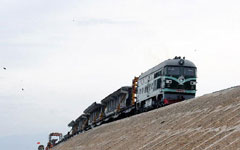Xinjiang braces for first high-speed railway
(Xinhua) Updated: 2014-06-05 10:38
 |
|
The trial run for the first high-speed railway in Xinjiang Uygur autonomous region started on Tuesday, marking a countdown to formal operations by the end of the year and a confidence boost to the region.[Photo/Xinhua] |
URUMQI - The trial run for the first high-speed railway in Xinjiang Uygur autonomous region started on Tuesday, marking a countdown to formal operations by the end of the year and a confidence boost to the region.
A CRH2-061C high-speed train ran through the 300-km Urumqi-Shanshan section at speeds of 160 km to 277 km per hour. The designed speed is 250 km per hour, but the train must slow down when passing through windy areas.
The train is part of the Second Double-track Line of the Lanxin Railway, which links Lanzhou city in northwestern Gansu province and Urumqi.
 |
|
 |
During the test run, Adi Turdi, 34, became the first Uygur man to operate a bullet train. He normally operates the train from Urumqi to Hami at a speed of 140 km per hour.
The trial run included tests on dynamic response, rails, communications and aerodynamics, and all results were within safety limits, said Fu Lianzhu, chief engineer of the line's trial run project.
Since the railway passes four major windy areas in China, a 462-km wind shield was built to prevent any damage caused by gales, said Fu.
The Lanxin Railway is currently the only railway connecting Xinjiang with other provincial regions. The new line takes a slightly different route, winding into neighboring Qinghai province before re-entering Gansu and picking up the old route that heads northwest toward Xinjiang.
The operation of the new line will complement the current railway networks and serve more of the population, said Erkin Tuniyaz, vice chairman of the regional government.
The line will greatly improve Xinjiang's transport capabilities to Central Asian and European countries and strengthen its role of being the transportation hub along the Silk Road Economic Belt, he said.
- Russia, China inch toward another gas contract
- Nation edges toward ending State monopoly on oil
- Changing dynamics in housing market 'normal'
- Offshore gold contracts to be traded in FTZ
- Qingdao Port: Shipments unaffected by investigation
- New credit ratings agency in the works
- E-commerce potential still robust in most Chinese cities
- Sino-US business ties still 'positive'

















